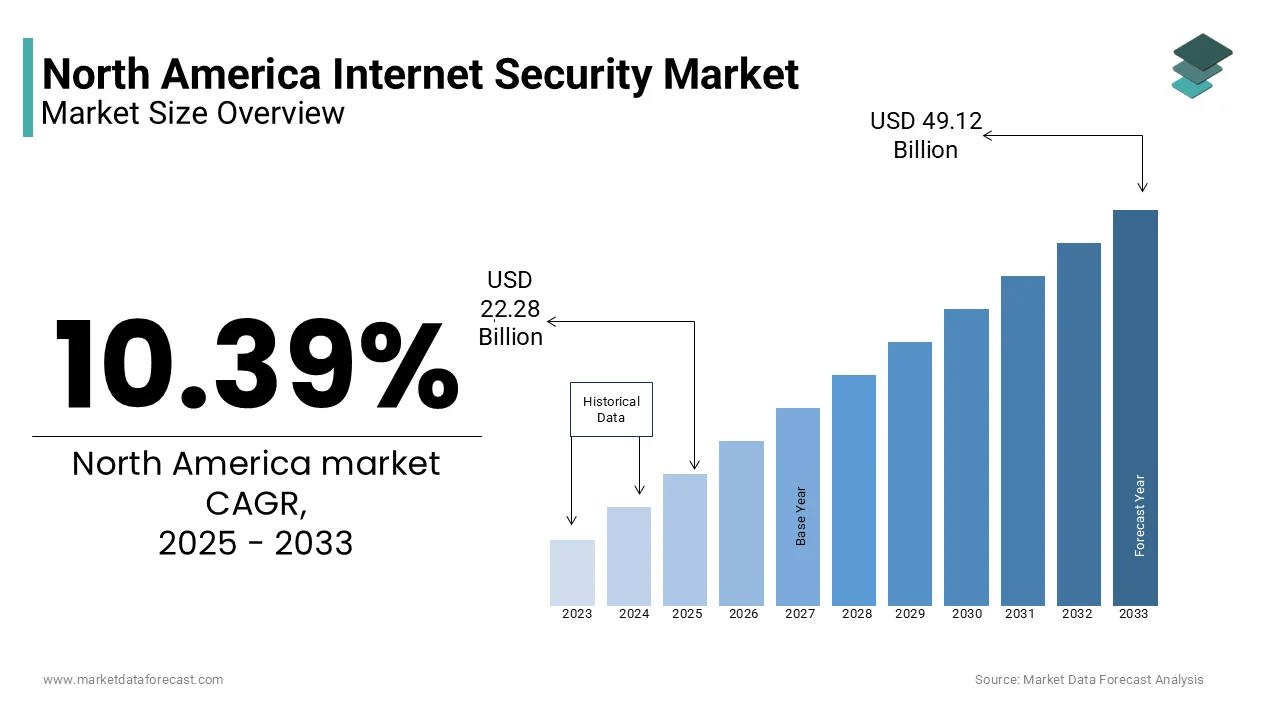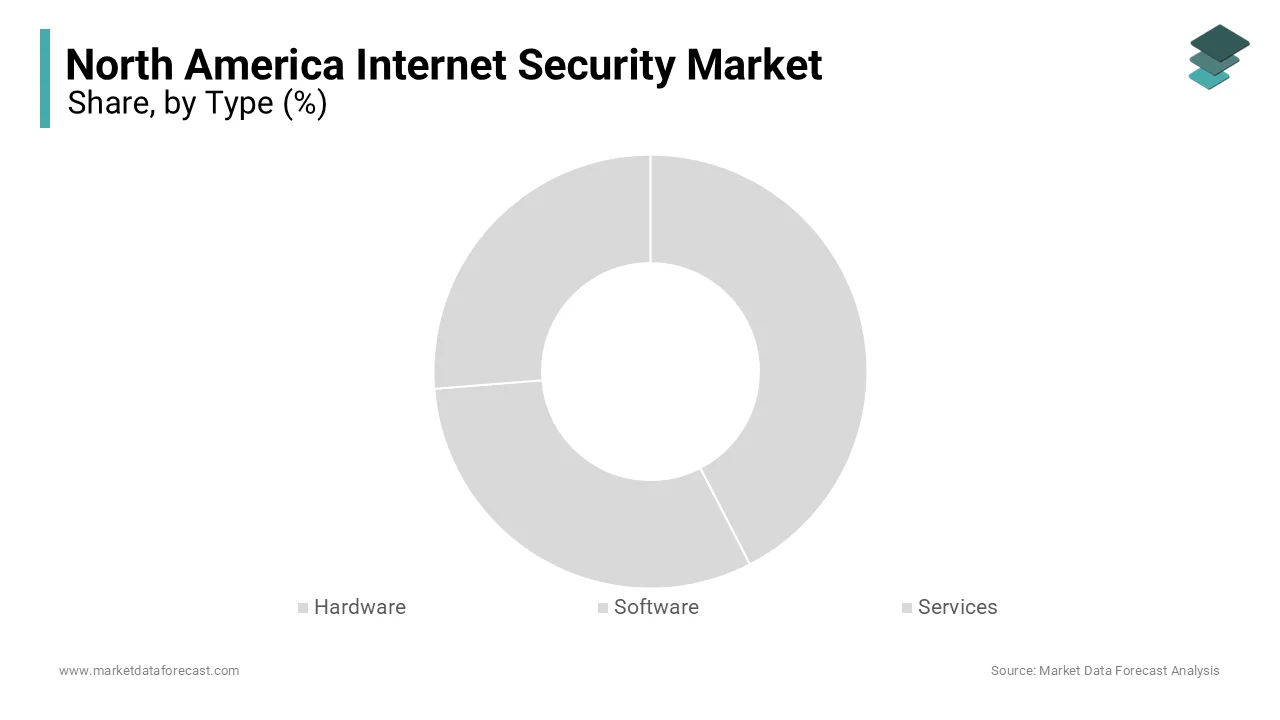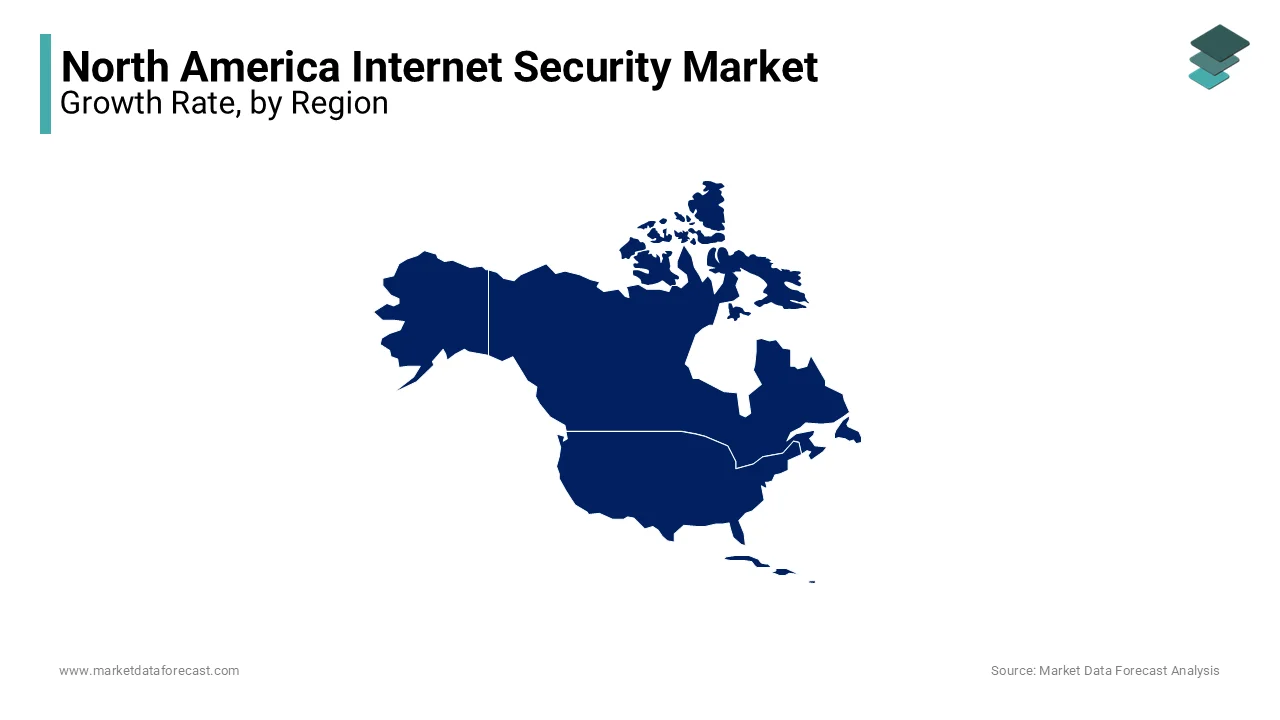North America Internet Security Market Size, Share, Trends, & Growth Forecast Report by Type (Hardware, Software, Services), Technology (Authentication, Access control technology, Content filtering, and Cryptography), and Application (BFSI, IT & Telecommunications, Retail, Government, Education, and Aerospace, defense & intelligence) - Industry Analysis From 2024 to 2033
North America Internet Security Market Size
The North America Internet Security Market was worth USD 20.18 billion in 2024. The North America market is expected to reach USD 22.28 billion in 2025 and USD 49.12 billion by 2033, growing at a CAGR of 10.39% during the forecast period 2025 to 2033.

Internet security solutions are used to protect the computer system and ensure the perfect execution of activities. The Internet is an insecure channel for sharing information based on intrusions such as fraud or phishing. The protection and transmission of data over the Internet use a variety of methods, including data encryption, firewalls, antivirus and more. As more people and organizations connect to the Internet through the web and email, VoIP and other services worldwide, threats to security increase day by day. Such attacks continue to evolve with more sophisticated and technological advances.
MARKET DRIVERS
The greater use of the Internet due to advances in wireless communications technology
The main drivers of the North America Internet security market are the greater use of the Internet due to advances in wireless communications technology, Internet security through cloud services, strict government regulations and increased financial activity online. Internet security and defense against online threats are even more critical in today's digital transformation environment. Fraud, cybercrime, risks, threats and vulnerabilities have multiplied and become important within an organization.
Internet security solutions cover a wide range of industries, including banking financial institutions and services, retail, telecommunications and information technology, government, manufacturing, education, defense, aerospace and others. In the fiscal year 2016, government agencies reported 30,889 cases related to information security. A good example is the United States and Russian coalition on the first bilateral agreement on confidence-building measures in the cyber domain. These events highlight threats and problems to recognize people and turn them into potential customers of companies in the Internet security market. Antivirus solutions are the most widely used method to prevent Internet threats since they have the ability to prevent malware from physical and remote access points.
MARKET RESTRAINTS
With the advent of AI, cyber attackers are now taking advantage of AI along with machine learning to make cybercrime harder and harder to detect. Responding to these improved forms of intrusion with cheap Internet security products is the most challenging task on the market. The need for innovative and efficient Internet security will arise in the coming years.
REPORT COVERAGE
|
REPORT METRIC |
DETAILS |
|
Market Size Available |
2024 to 2033 |
|
Base Year |
2024 |
|
Forecast Period |
2025 to 2033 |
|
CAGR |
10.39% |
|
Segments Covered |
By Type, Technology, Application, and Region |
|
Various Analyses Covered |
Regional & Country Level Analysis, Segment-Level Analysis, DROC, PESTLE Analysis, Porter’s Five Forces Analysis, Competitive Landscape, Analyst Overview on Investment Opportunities |
|
Countries Covered |
The United States, Canada, Mexico, and Rest of North America |
|
Market Leaders Profiled |
MacAfee, AVG Technologies, Palo Alto Networks, Kaspersky Lab, Trend Micro Inc., Symantec Corporation, Cisco Systems, IBM Corporation, Dell Root 9B, Fortinet Inc., Imperva Inc., CyberArk Software Ltd, and others. |
SEGMENTAL ANALYSIS
By Type Insights
Based on the type, the North American Internet security market is divided into software, hardware and services. The software was the segment with the highest revenue in 2024, and the service segment is foreseen to record the highest growth rate during the estimated period. The increasing adoption of antivirus and firewall securities by large, small and medium enterprises has contributed to the growth of the software segment in the regional market.

By Technology Insights
Based on technology, the North America Internet security market is classified as an authentication technology, access control technology, content filtering and encryption technology. Of these, the authentication segment was the most profitable sector in 2024, owing to the strict login mechanisms required to protect the confidential information from extruders or unauthorized access.
By Application Insights
Based on the application, the defense/government applications sector led the regional market in 2024, representing almost 27.0% of total sales. High spending on security solutions and concerns about data leakage from intelligence, research and development and financial activities can lead to cyber terrorism, which is acting as a catalyst for the development of this sector.
REGIONAL ANALYSIS
North America dominated the market in 2024, representing 38.3% of total sales. Its growth is due to the presence of prominent players that provide advanced solutions and services to all sectors of the region. In addition, as SMEs become more aware of internet security, it is expected that demand for cybersecurity solutions increase during the forecast period.

The United States internet security market is expected to represent more than half of the North American business. It has also been reported that the average cost of cybercrime in the United States is rising continuously. This is one of the main reasons why the United States invests significant sums in prioritizing internet security and addressing cyber threats. Canada internet security market is also expected to witness a high growth rate during the forecast period.
KEY MARKET PARTICIPANTS
Major industry players include MacAfee, AVG Technologies, Palo Alto Networks, Kaspersky Lab, Trend Micro Inc., Symantec Corporation, Cisco Systems, IBM Corporation, Dell Root 9B, Fortinet Inc., Imperva Inc., CyberArk Software Ltd, and others.
Leading Company
Symantec Corporation provides a platform for integrated security analysis provides analysis of big data, improves security applications Symantec and third parties, and provides visibility of global threats in real time.
RECENT HAPPENINGS IN THE MARKET
- In 2017, New York announced a regulation that requires financial institutions to organize detailed programs to protect customer data and train employees from identifying threats.
- Dell's January 2019 press release recreated the endpoint security portfolio through strategic collaboration with Secureworks and CrowdStrike to close the cybersecurity technology gap and help organizations address these issues. Introducing Dell SafeGuard and Response, a collection of next-generation endpoint security solutions.
- In the 2018 annual report, Microsoft stated that cybersecurity is a critical challenge in the digital age and is innovating to provide end-to-end security to customers with a global security operation that analyzes more than 6.5 billion signals from security every day. Microsoft leads the Cybersecurity Technology Agreement, signed by 61 global organizations, and urges the government to do more to ensure Internet security.
This research report on the North American Internet Security market has been segmented and sub-segmented based on the following categories.
By Type
- Hardware
- Software
- Services
By Technology
- Authentication
- Access Control
- Content Filtering
- Cryptography
By Application
- BFSI
- Information Technology
- Telecommunications
- Retail
- Government/Defence
- Education
- Healthcare
- Aerospace
By Region
- The United States
- Canada
- Rest of North America
Frequently Asked Questions
Which industries in North America are the largest consumers of internet security solutions?
The largest consumers are the financial services sector, healthcare, and government agencies. These industries handle sensitive data and are prime targets for cyber attacks, necessitating robust security measures.
What are the most common types of cyber threats in North America?
The most common cyber threats include ransomware attacks, phishing schemes, malware infections, and data breaches. These threats target both individuals and organizations, making comprehensive internet security essential.
What are the major challenges facing the North America Internet Security Market?
Major challenges include the constantly evolving nature of cyber threats, a shortage of skilled cybersecurity professionals, and the high cost of implementing comprehensive security solutions. Additionally, small and medium-sized businesses often struggle to afford the necessary security measures.
What are the future trends expected in the North America Internet Security Market?
Future trends include the adoption of artificial intelligence and machine learning for threat detection and response, increased use of zero-trust security models, and greater emphasis on securing Internet of Things (IoT) devices. There will also be a focus on improving security awareness and training programs to combat human error.
Related Reports
Access the study in MULTIPLE FORMATS
Purchase options starting from $ 2000
Didn’t find what you’re looking for?
TALK TO OUR ANALYST TEAM
Need something within your budget?
NO WORRIES! WE GOT YOU COVERED!
Call us on: +1 888 702 9696 (U.S Toll Free)
Write to us: [email protected]